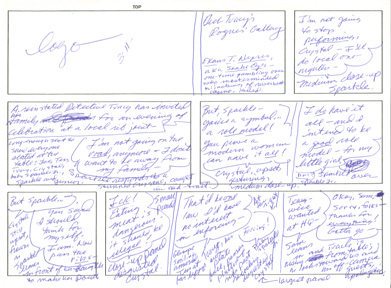As a virtual supplement to our exhibit The Comics Continuum (on view in the Main Library 3rd floor hallway, now through November) this fall we are featuring items from our comics collections on the Special Collections & University Archives blog. Below we’ve described two examples of collaboration in comics from the exhibition, but please explore our collections on your own! Comic Books in Special Collections is a good place to start online, or come into the reading room and check out the cart of comics material we’ve pulled out of the stacks.
While many comics from idea to finished product are the work of a single artist, collaborative work is an important part of the history of comics, both in the mainstream and experimental realms.

The Papers of Max Allan Collins, a UI alumnus, screenwriter, and novelist, contain records of Collins’ correspondence, notes, and writing as he created comics with collaborators who contributed ideas and characters (including Mickey Spillane, for Mickey Spillane’s Mike Danger), art (including Terry Beatty, for Ms. Tree), and lettering. Collins also has worked to adapt/revive existing comics, as well as the expectations of their fans, in the case of Dick Tracy and Batman. His papers provide insight into both of these processes, including research and analysis of a comic’s themes and style and creating new stories and sketches that appeal to a contemporary audience and meet the approval of the publisher.
In a letter to the Dick Tracy artist Rick Fletcher from 1980, Collins describes some of the difficulties and compromises inherent in collaborative work:
“Will do my best to describe wardrobe, situations, ‘up front’ – I try to be very specific in my panel descriptions and at the same time not hamstring you; a delicate balance. Occasionally this sort of thing is bound to happen, considering we collaborate largely by mail.”
Another item in the exhibition that features collaboration is C Comics No. 2. This 1965 publication is one of only two issues produced as a continuation of C: A Journal of Poetry, which was edited by the poet Ted Berrigan. C Comics is the result of collaborations between visual artist Joe Brainard and a number of poets associated with the New York School including Berrigan, John Ashbery, Frank O’Hara, and Kenneth Koch. Much of Brainard’s other artwork uses comic conventions or existing comic characters like Nancy, and in C Comics the combination of semi-abstract images, re-appropriated characters, unusual layout, and the language of the New York School of Poets creates an innovative form of comics, a precursor to modern experimental and artistic comics of all types.

Rather than set existing poetry in comic form, as others have done, Brainard drew the graphic parts of the comics (sometimes straightforward, sometimes abstract or absurd) with blank spaces and asked his poet collaborators to fill them in with words. In addition to this issue of C Comics, Special Collections has a number of books on Brainard, including Ron Padgett’s Joe: A Memoir of Joe Brainard, in which he describes a later comics collaboration between artist and poet:
“Knowing that Joe preferred not to do the kind of messy, spontaneous, simultaneous collaborations that we had done [earlier], I wrote a text–a pseudo-professorial statement–that I thought could be adapted to the comic strip form. Then Joe and I set about looking through his … postcard collections, selecting images that jumped out at us. We quickly put them in a sequence, sometimes matching image and text, sometimes going against an overt connection. In light of the images, I made a few final revisions of the text. Joe then redrew everything in black and white, and I lettered in the words” (163).